Filipino Diabetic Meal Plan: 7-Day Powerful & Healthy Guide
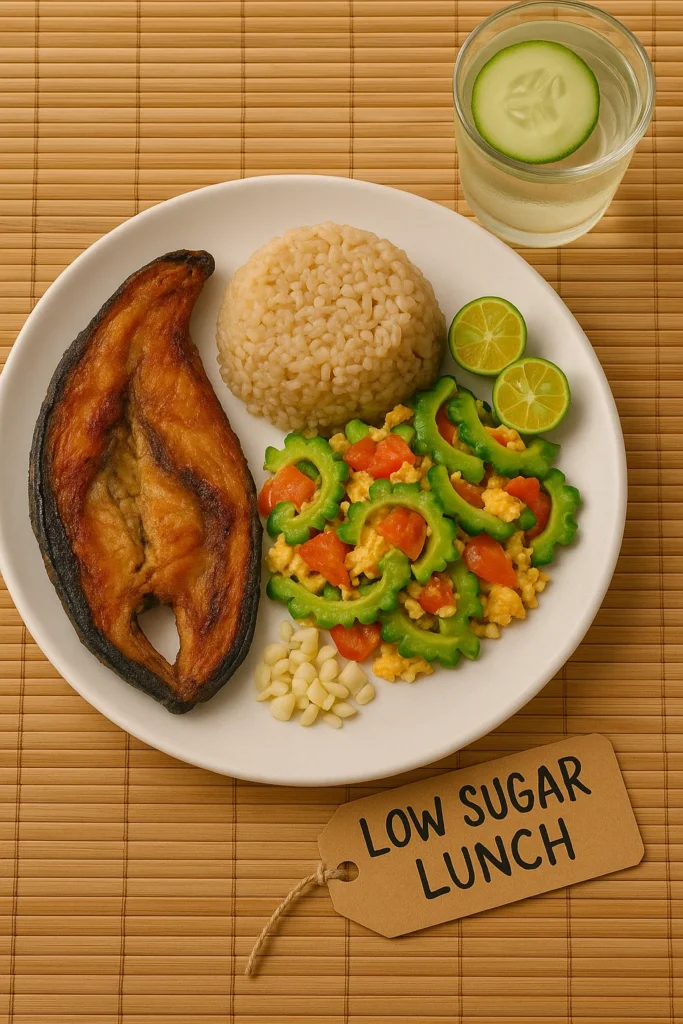
Your guide to simple, local, and blood-sugar-friendly Pinoy meals “The Philippines now has over 4 million diagnosed diabetics — and that number keeps rising.” – Philippine Society of Endocrinology Filipino diabetic meal plan — it sounds like something you’d see in a brochure or a clinic wall. But for our clients, it became real the day were diagnosed with Type 2 diabetes. They didn’t panic — but they did pause. Every meal mattered now. They couldn’t just cook whatever was in the fridge. Suddenly, they had to think in terms of low sugar meals, portion control, and smart swaps — and still keep it delicious. If you’re reading this, chances are someone you love (maybe even you) is going through the same thing. That’s why I want to share a real, doable Filipino diabetic meal plan, using ingredients you can find at your local market or grocery. No intimidating “superfoods” or foreign recipes. Just good, homegrown food that works. What Makes a Filipino Diabetic Meal Plan Work? Let’s be real — food is central to Filipino life. Every celebration, every weekend, every stressful moment is tied to what’s on the table. That’s why managing diabetes through diet hits close to home. It’s not just about nutrition; it’s about culture, tradition, and love. A diabetes diet plan in the PH doesn’t mean cutting out rice completely or saying goodbye to all your favorite dishes. It means finding balance is more important now than ever. It’s about keeping your blood sugar steady — not spiking and crashing like EDSA traffic during rush hour. For our clients, we always urge them to start small. No sudden bans. No shaming. Just quiet, steady changes. Like what they can do with rice. At first, our clients were confused. They never imagined they could eat rice ever again. But after a week or two? They thank us because they never feel deprived. We also help our clients start cooking more vegetables. But not plain ones. They can sautée eggplants with garlic. They turn upo into soup with ground chicken. They make chopsuey with less oil and lots of color. Our dining table started to look brighter. Here’s what helped they say helped them the most: Also — we made snacks part of the Filipino diabetic meal plan. Skipping meals led to overeating, which caused unnecessary sugar spikes. So we built in small, protein-rich snacks to help clients keep their blood sugar stable. The beauty of a Filipino diabetic meal plan is that it doesn’t need to erase cultural comfort. A well-balanced Pinoy diabetic diet can still feature tinola, sinigang, and inihaw — as long as we’re mindful with portions and ingredients. You just learn to build the plate better. Add veggies. Limit rice. Choose lean meat. Adjust slowly. So yes — it takes work. But not misery. Not if you approach it with care, creativity, and a dash of calamansi. With the right tweaks, the Filipino diabetic meal plan can feel less like a diet and more like a return to home-cooked simplicity — only smarter and healthier. Sample Filipino Diabetic Meal Plan for the Day This sample Filipino diabetic meal plan isn’t a one-size-fits-all. But it’s a great starting point. Here’s how it looks when broken down into a day: Breakfast Why it works: Oats are rich in soluble fiber, which helps regulate blood sugar. The egg provides healthy fat and protein that balances the meal. And the banana? It’s nature’s candy — but in the right amount. This trio works beautifully together in any Filipino diabetic meal plan. Mid-Morning Snack This snack is a breakthrough for most. We realized not every snack needs to be something fried or starchy. Sometimes crunch is enough. Keep a container of pre-cut singkamas in the fridge for easy grabs. Lunch One trick we discovered is soaking the ampalaya slices in salt water for 10–15 minutes before cooking. It removes most of the bitterness without killing its nutrients. Even my niece, who’s 7, eats it now. Afternoon Snack The egg is a go-to because it’s filling and quick. But on days when you have a little more prep time, lumpiang ubod with fresh veggies and coconut strips wrapped in soft lumpia wrapper made for a satisfying treat. Just skip the sugary sauce and opt for vinegar dip. Dinner Pro tip: Avoid sweetened sauces, soy-heavy dishes, and food that’s mostly fat. But you can keep the flavor — think herbs, spices, calamansi, suka. Before Bed (if hungry) This part of the Filipino diabetic meal plan is crucial. Going to bed hungry can cause blood sugar to drop — or spike by morning after your breakfast. Most clients learned this the hard way. We’re not aiming for restriction. We’re aiming for sustainability. And with a Filipino diabetic meal plan that actually uses local ingredients and celebrates our food culture, it’s possible to eat well, stay healthy, and still feel like you’re enjoying every bite. If you’re building a plan for someone you love, start here. Adjust based on their preferences and medical needs. And remember — it’s not just about blood sugar. It’s about making meals feel safe, nourishing, and familiar. Tips for Sticking to Your Filipino Diabetic Meal Plan Let’s face it — any diet can feel like a chore if it’s done alone or if it completely removes the joy from food. That’s especially true with a Filipino diabetic meal plan. We love flavor. We love gatherings. We love rice! So if we want to make this work long-term, we have to build habits that fit into our real lives — not fight against them. 1. Eat with the family.Don’t isolate the diabetic. Eating healthy shouldn’t feel like exile. Start preparing meals that everyone could enjoy, not just the person with diabetes. Tinola without chicken skin? Still delicious. Stir-fried kangkong with garlic? Everyone loves it. It will make them feel supported, not singled out. The Filipino diabetic meal plan became a family journey — not just their battle.
Kidney-Friendly Filipino Diet

Kidney-friendly Filipino diet meals are more than possible—they’re delicious, healing, and made with love. Whether you’re managing CKD or supporting a loved one, small changes to traditional dishes can make a big difference. By following key CKD nutrition tips and incorporating low sodium Filipino food alternatives, you can support kidney health without giving up the flavors you love. For more information on how kidney disease affects diet, visit the National Kidney Foundation’s Nutrition Guide. “One out of 10 Filipinos may have chronic kidney disease (CKD), and most don’t even know it.”— Philippine Society of Nephrology That’s not just a number. That’s someone’s mother, uncle, best friend—or maybe even you. When my client was diagnosed with early-stage CKD, it shook him. He didn’t look sick. He felt fine. But his labs told a different story. The doctor sat him down and said, “No more salty food. Less meat. Watch the potassium.” He remembers looking at his weekly meal plan and thinking—how do you even do that in a Filipino household? Let me tell you—it’s not easy at first. But it’s not impossible. You don’t have to give up every favorite dish. You just have to tweak it. This post is for anyone looking for a real-world, kidney-friendly Filipino diet—the kind that fits your lifestyle and still tastes like home. What Makes a Kidney-Friendly Filipino Diet? When your kidneys aren’t working well, they can’t get rid of waste the way they should. That means we need to ease their workload. A good kidney-friendly Filipino diet does just that—using local ingredients and realistic changes. The basic rules? Lower sodium, control protein, watch potassium and phosphorus, and manage fluids. Sounds complicated, right? But here’s what it would look like for you in real life: These are general tips to creating a kidney-friendly Filipino diet that can work for you but remember to always consult a dietitian. YOU% offers online nutrition services no matter where you’re from (imagine having your own personal dietitian!). It’s not just about removing ingredients. It was about replacing them with better choices. Instead of instant noodles, you can start cooking mami with fresh chicken breast, homemade broth, and thin pechay. Less seasoning packets. Still flavorful, still satisfying, and very much aligned with a kidney-friendly Filipino diet. Another big win can be how you handle condiments. This can be a turning point in your kidney-friendly Filipino diet journey. Instead of soy sauce, lean towards dipping sauces made with calamansi, crushed garlic, and a tiny dash of vinegar. It will amaze you how those simple swaps added so much flavor without compromising kidney health. You can even make your own salt-free adobo mix using bay leaves, peppercorns, and apple cider vinegar—one of the easiest and most impactful CKD nutrition tips our clients have picked up from working with YOU%. These little hacks make a big difference in lowering sodium, while keeping Filipino meals comforting and familiar. Even small things helped. Things like removing the skin from chicken, grilling or steaming more instead of frying everything. And watching portions more closely—especially the your viand-to-rice ratio, which is often way off in a typical Filipino plate. One surprising thing you’ll notice? The food won’t taste bland. Once your taste buds adjust, everything will feel lighter and more natural. And when my client’s follow-up blood work came back and had improved, they knew they were on the right path. It gave them proof that a kidney-friendly Filipino diet wasn’t just doable—it was effective. This is what a kidney-friendly Filipino diet looks like in real homes. It’s not about perfect meals—it’s about daily decisions. Replacing instead of removing. Adjusting, not giving up. And always keeping flavor at the heart of the plate. Don’t be afraid to get creative in the kitchen. Start slow. Swap one ingredient. Try one new recipe. Look at what’s already in your pantry and think, “How can I make this kidney-safe without losing the taste?” Over time, your body—and your kidneys—will thank you. Your energy will improve. Your digestion will feel better. And most importantly, you’ll start to enjoy meals again, without the guilt or stress. It’s not a quick fix. But it’s one of the most loving things you can do for yourself or someone you care for. With a kidney-friendly Filipino diet, every meal becomes a step toward healing, not just eating. Real Renal-Safe Meals in PH That Even You Can Cook We make sure our clients don’t feel like they’re on some depressing “diet.” We just help them make adjustments. They’ve learned (and you can too!) that a kidney-friendly Filipino diet doesn’t mean eating bland, boring meals. It means choosing wisely and being creative with what’s already in your kitchen. Here are a few renal-safe meals in PH that worked for our clients—and they might work for you, too: 1. Ginisang Upo with Ground Chicken (no fish sauce)Upo is low in potassium and super affordable. Ground chicken gives you protein without overloading the kidneys. They use garlic, onions, a splash of vinegar, and salt-free seasoning like herbs and a bit of turmeric. My client used to be skeptical, but now he actually makes this dish daily. 2. Sayote and Chicken SoupThink of it as tinola reimagined. We use sayote—another kidney-friendly vegetable—and less broth than usual. Instead of fish sauce, we add ginger, onions, and a dash of calamansi. It’s warm, comforting, and light on the kidneys. 3. Grilled Eggplant with Garlic and Vinegar DipWe roast the eggplant until soft, then mash it slightly and serve with garlic and a vinegar-based dip. Instead of soy sauce, our clients use calamansi with a bit of sugar-free ketchup. This dish is always on their weekly menu. It’s THAT good. 4. Adobo with a TwistYes, you can still enjoy adobo! We use lean pork or skinless chicken thighs, skip the soy sauce, and flavor it with vinegar, garlic, bay leaf, and a little olive oil. Sometimes we throw in a bit of chopped sayote to stretch the serving and add more fiber.
7 Foods to Lower Blood Pressure in the Philippines
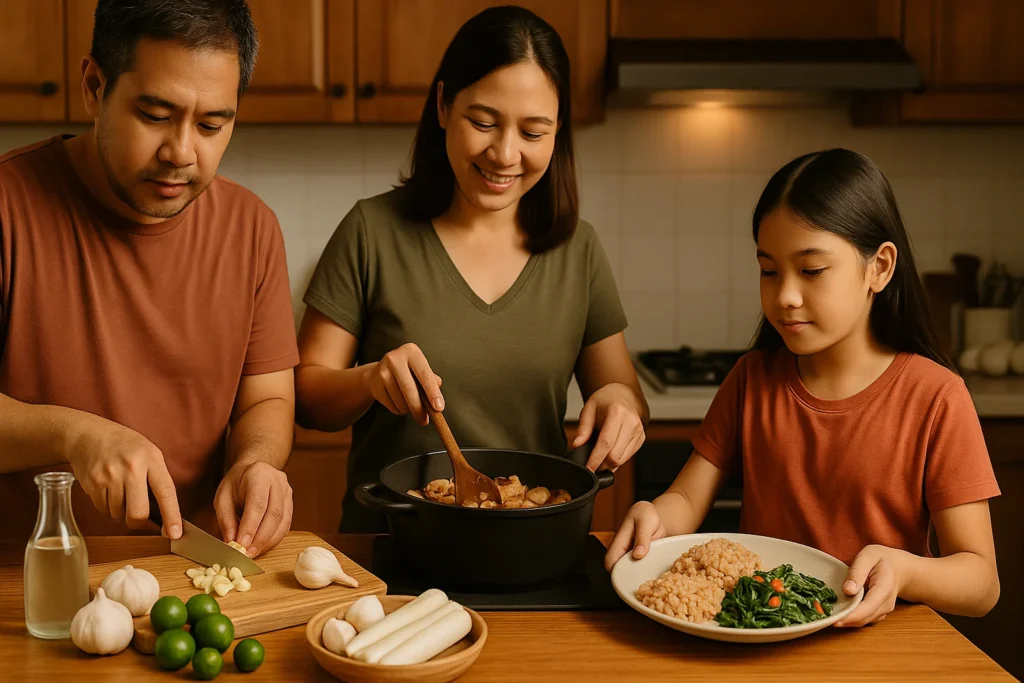
Natural, local, and simple steps to keep your heart healthy—Pinoy style Foods to lower blood pressure in the Philippines aren’t hard to find — they’re already in your kitchen. And they could be the difference between a healthy life and a silent, dangerous condition. According to the World Health Organization, “Hypertension is the leading cause of early death in the Philippines.” That hits a lot of Filipinos hard. But it also makes sense. In our family alone, I can count five people with high blood pressure. My dad, my tito, my lola, and even one of my cousins — and he’s only 23. What’s wild is that most of them didn’t feel sick. They were just tired or feeling out of breath after walking a flight of stairs. That’s how sneaky hypertension can be. When a client’s blood pressure spiked during a routine check-up, it scared them. They knew they couldn’t rely on medicine alone. Our client had to get serious about natural blood pressure control — and they could do it without giving up the food they love by working with YOU% Nutrition. A Hypertension Diet Plan in PH That Still Includes Adobo When people hear about a hypertension diet plan in PH, they imagine bland meals — steamed veggies, no salt, no flavor. But that doesn’t have to be the case. Our clients still eat adobo. We just switched it up: chicken breast instead of pork belly, less soy sauce, and more vinegar. They still enjoy sinigang, too — with more veggies like labanos and sitaw, and leaner meat. We realized something important early on: we didn’t need to completely throw away our food culture just to be healthy. We just needed to reframe it. My partner was the first to say it — “Let’s just make smarter choices with what we already love.” We started with small tweaks. We began by making adobo with leaner cuts. We also learned to balance soy sauce with vinegar, garlic, and peppercorns to keep the flavor strong, but the sodium low. One time, we even added pineapple chunks to chicken adobo. We were skeptical, but wow — that sweet-sour blend hit the spot and felt lighter than the traditional version. Portion control helped, too. Instead of piling the plate with rice and meat, we shifted the ratio. More gulay, less kanin. And honestly, we didn’t feel deprived. In fact, our clients felt better too — lighter, more energetic, less sluggish after meals. We also experimented with healthier oils. Instead of frying, we learned to braise or grill meats. For adobo, slow-cooking in a thick-bottomed pot brought out the flavors without needing tons of fat. Sometimes we used canola oil in small amounts, which gave a subtle nutty aroma that made dishes feel indulgent — even if they were low-sodium. Even the way we served food changed. We moved to smaller plates. Sounds simple, but it worked. Smaller servings looked full, and it encouraged us to eat slower. Less mindless eating, more enjoyment. Another surprise? One of our client’s mother started helping in the kitchen. It was a way for them to take control of their health. The mother would slice veggies, prepare the garlic, or make sawsawan with calamansi and pepper instead of soy sauce. Having her involved made the meals feel like shared victories. So yes, a hypertension diet plan in PH can absolutely include adobo. It can include your favorite Filipino meals. The key is to prepare them with care — to know your ingredients, be intentional with your choices, and involve your family. Because when your health journey doesn’t feel like punishment, it’s easier to stick with. And when the food still brings you joy? That’s when real, lasting change happens. That mindset made a huge difference for clients working with YOU% Nutrition. Healthy Pinoy Meals That Help Lower Blood Pressure Our clients used to think “healthy meals” meant expensive salads or foreign superfoods. But we changed their perception. What really made a difference for a client’s blood pressure were the healthy Pinoy meals they grew up with — just reimagined. Meals that are simple, natural, and deeply Filipino. That realization saved them a lot of stress and money. Every food listed here became a regular part of some of our clients’ weekly routine. We sourced most of them from our local markets. Affordable, accessible, and, most importantly, effective. These aren’t trend-driven fads. These are real foods to lower blood pressure in the Philippines that your own family probably eats already. Let’s dive into what worked. 1. Malunggay We add malunggay to almost everything — tinola, monggo, even scrambled eggs. This leafy green is a powerhouse. It’s packed with potassium and magnesium, both essential for helping the body regulate blood pressure. My aunt even dries malunggay leaves and turns them into tea. At first, we all laughed about it, but it surprisingly tasted good — and it helped my uncle who also has high blood pressure. Plus, growing malunggay at home? Super easy. Most families plant one in an old paint bucket outside and it just kept providing. 2. Kamote Kamote is one of those quiet heroes. High in fiber, naturally sweet, and full of potassium, it supports heart health while also satisfying carb cravings. You can replace white rice with kamote at least twice a week. Get into the habit of boiling kamote in the morning and storing it for later snacks. So simple. No need to overthink it — just slice and serve. You can even mash it with a bit of cinnamon powder and it will taste like a fancy dessert. 3. Saging na Saba (Boiled) This was a game-changer when some of our clients were trying to quit sugary merienda snacks. Boiled saba — no sugar added, no frying — became his go-to. It’s naturally sweet and packed with potassium. They eat one mid-morning and another after lunch if he’s still feeling hungry. It helped control his cravings and stabilized his blood pressure.
Healthy Filipino Recipes for Weight Loss: 7 Easy Meals
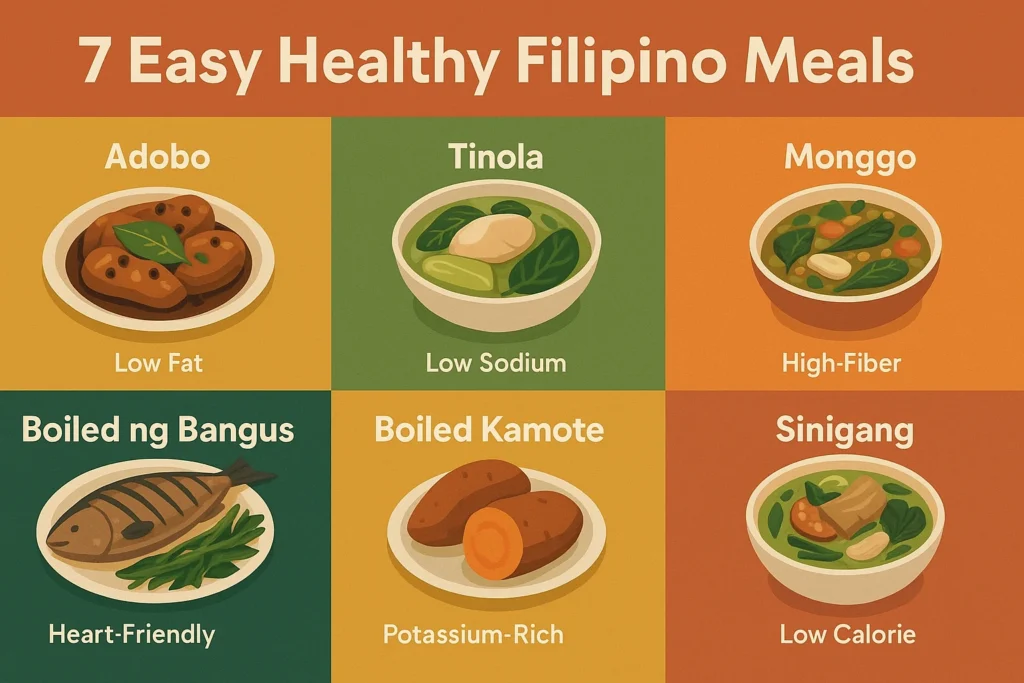
Healthy Filipino recipes for weight loss don’t have to be complicated — and they definitely don’t have to be boring.
5 Proven Weight Loss Tips in the Philippines
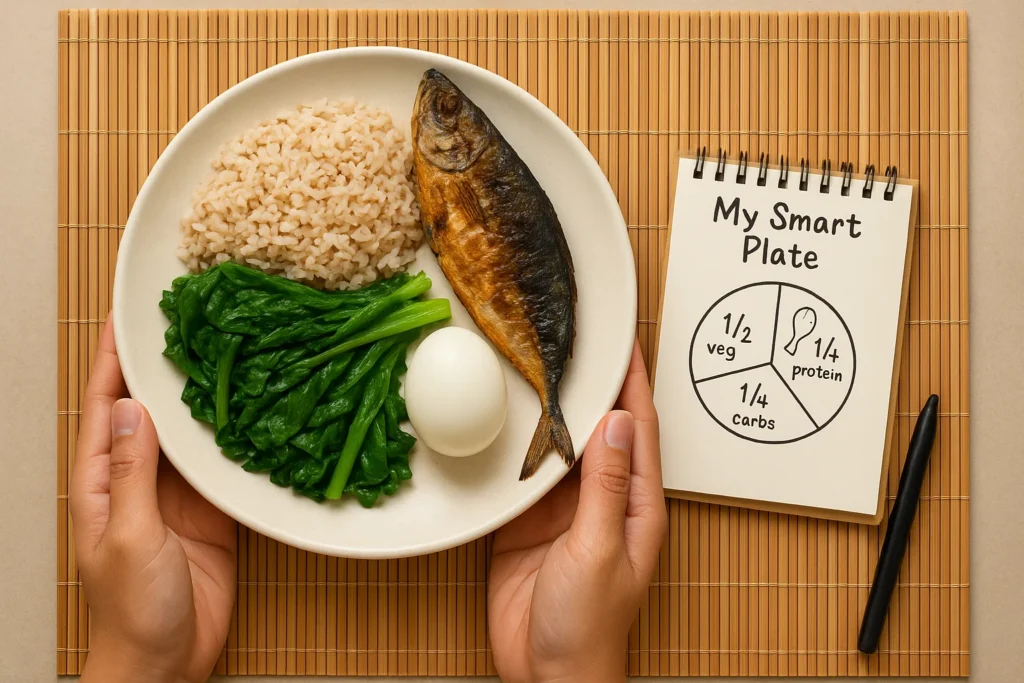
Weight loss tips in the Philippines aren’t about cutting carbs completely or following foreign trends. They’re about making small, smart choices that work for our Filipino lifestyle—meals we grew up with, habits that fit our routines, and strategies that feel doable. “Around 27 million Filipino adults are overweight or obese.”(Source: Food and Nutrition Research Institute) That stat hits a lot of Filipinos hard. Not because they love numbers, but because they are a part of it. A lot of our clients were the kind of persons who always said, “I’ll start Monday.” But Mondays came and went. What finally worked for them wasn’t a fancy gym or some expensive imported diet—it was embracing simple, Filipino diet tips, joining local weight loss programs, and following everyday weight control strategies that fit into life here in the Philippines with help from YOU%. If you’re reading this, chances are you’re ready to feel better in your own body. And this guide is here to help you do just that—without gimmicks, starvation, or shame. 1. Filipino Diet Tips That Actually Work When it comes to weight loss tips in the Philippines, food is always the first battleground. We love to eat—it’s how we celebrate, bond, and unwind. So it makes sense that if we want to feel better and lose weight, we have to start with our everyday Filipino meals. No need to go all-organic overnight or cut out rice completely. Honestly, I still eat rice. I just eat less of it—and pair it with more vegetables and protein. Here’s what helped me: These small changes didn’t feel like a diet. They felt like better versions of the food I already loved. That’s the power of Filipino diet tips—you don’t need to give up your culture, you just tweak the plate. One of my go-to meals? Tinola. I cook it with plenty of sayote and malunggay, skip the skin on the chicken, and eat it with half a cup of rice. It’s comforting, satisfying, and light. Another favorite? Monggo with ampalaya leaves and a bit of fish flakes. High in fiber, rich in nutrients, and budget-friendly. Even adobo is doable—just lessen the oil and stick to lean cuts. You’re still eating real food, just with smarter portions and better balance. Another Filipino diet tip I learned from my partner: eat with intention. He would always chew slowly, eat quietly, and stop when he felt just right—not full, not hungry. I try to do the same. It keeps me from overeating and helps me enjoy my food more. When in doubt, I follow this visual: half a plate of veggies, a quarter for rice or kamote, and the rest for protein. Simple, flexible, and very doable in any Filipino household. If you’re trying to lose weight in the Philippines, don’t chase foreign trends. Use what we already have—fresh local vegetables, fish, eggs, rice, fruit. Adjust how much, how often, and how you prepare it. Filipino diet tips work best when they’re based on real life. Don’t wait until you’ve bought fancy ingredients or joined a meal plan. Just open your fridge, plan around what’s there, and make small shifts every week. Progress beats perfection. Every smart plate is a win. Keep going—you’ll feel the difference. 2. Local Weight Loss Programs and How to Get Moving Let’s be real—gym memberships can be expensive, crowded, and honestly, a little intimidating if you’re just starting out. I tried going to the gym. I even paid for a 6-month plan. But after the plan ended, I never went back. Not because I didn’t want to improve, but because it was just too much of a cost. That’s when I decided to keep it simple. I started walking. First, just around the house. Then around the block. Eventually, I was walking 30 minutes a day after dinner. No pressure, no gear, no crowd—just movement. I also started doing short workouts and dances I found on YouTube. There are plenty of 10- to 20-minute routines designed for beginners. My favorite ones are low-impact, no equipment, and led by coaches who make it fun. Here are a few ideas that got me started: Don’t underestimate these local weight loss programs especially the ones from YOU%. They’re practical, friendly, and usually built for real people with busy schedules and limited resources. And here’s the key—consistency over intensity. It doesn’t matter if you’re just walking, dancing in the kitchen, or doing squats while waiting for the rice to cook. Just move every day. Let your body build the habit. Some weeks a client can only manage three walks. Other weeks, they’re able to do five workouts. We remind them to don’t beat themselves up for it. Just keep going. The best weight loss tips in the Philippines aren’t about pushing yourself to extremes. They’re about moving more than you did yesterday—and making it feel like something you can actually stick to. If you’re looking for structure or accountability, don’t hesitate to book a consultation with YOU%. Sometimes, all it takes is one message or call to unlock a program that fits your lifestyle. No matter where you are in your journey, you can start today. One walk. One stretch. One song you dance to while cleaning. It all adds up. And most importantly? You’re not doing it alone. Your community is here. Your body is with you. And your goals are waiting. 3. Weight Control Strategies That Don’t Involve Giving Up Lechon Let me be clear—our clients still eat isaw. And kwek-kwek. And lechon, when there’s a reason to celebrate. But they learned this: the key to weight control strategies isn’t never eating your favorite food. It’s knowing how much and how often. That balance is what makes a healthy lifestyle sustainable. Here’s our trick: they eat what they want—but I stop at “full,” not “bloat.” A few strategies from us that worked for them: These sound simple, but they’ve helped our clients more than any diet ever did. It’s not about rules—it’s
Eating Healthy on a Budget in the Philippines: 7 Easy Tips
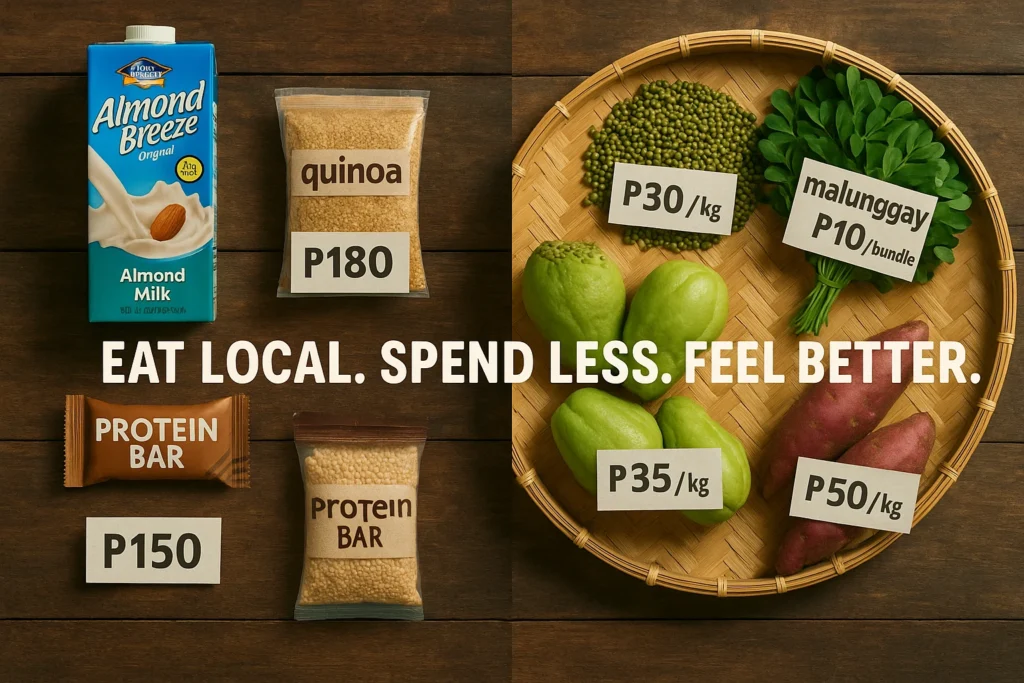
That’s a huge chunk of the budget—and for many families, it still ends up being filled with instant noodles, canned goods, and fast food. Our clients used to be the same. They thought eating healthy meant going to expensive organic stores, buying kale, quinoa, or almond milk. But when we made them take a step back and look at what was available locally, they realized they were wrong. Eating healthy on a budget in the Philippines is totally possible. You don’t need fancy ingredients. You just need a few smart habits and a new way of looking at the food we’ve had around us all along. Budget-Friendly Nutrition Doesn’t Mean Imported Food Let’s face it—when you think of “healthy,” your brain might go straight to protein bars, imported oats, and stuff that comes in glossy packaging. Our clients were the same. They used to skip right past the local section and head straight for those foreign brands in the grocery, thinking, “Well, this must be what healthy is like.” It’s not. And it doesn’t have to be. Eating healthy on a budget in the Philippines doesn’t mean emptying your wallet on so-called superfoods. It means embracing what’s already accessible and affordable. One afternoon before going to the market, a client had ₱150 and no clue what to make for dinner. She asked me during our consultation, “Ma’am, anong pwede sa ₱150 na pang-dinner?” and I gave her a recipe for tinola and just like that, she was reminded how our local meals are packed with nutrients and heart. Affordable Pinoy meals like tinola, monggo, and tortang talong are not only delicious—they’re packed with nutrients. Monggo, for example. Packed with fiber, plant-based protein, and iron. Pair it with malunggay—one of the most underrated greens we have—and you’re already giving your body a boost. I make a huge pot every week. It costs less than ₱50 to prepare and feeds me for days. With some fried garlic on top? Heaven. That’s eating healthy on a budget in the Philippines in action. And then there’s tinola. It’s one of those soul-healing dishes, especially on rainy days. You don’t need fancy cuts of chicken. Use necks or wings. Sayote or green papaya. Add ginger, onions, and a bit of patis. That’s it. One pot can feed a whole family. You get budget-friendly nutrition, warmth, and comfort. But healthy eating isn’t just about cooking. It’s also about what you don’t buy. When our clients stopped buying processed food, they realized they were actually saving money. No more ₱70 packs of cookies that disappear in one sitting. No more ₱50 sugar-loaded drinks. Just whole ingredients that stretch across multiple meals and support healthy living. They also started checking labels. They were shocked at how many “healthy” snacks were full of sugar or sodium. That’s what healthy grocery in PH looks like—knowing what you’re buying, and choosing wisely. So now, clients build their meals around what’s fresh, local, and cheap. Pechay, kangkong, kamote, itlog, saging. These are everyday ingredients that—when cooked right—taste amazing and fuel your body well. These staples are part of a budget-friendly nutrition toolkit. If you’re just starting out and unsure how to balance meals or make a weekly plan, don’t worry. You’re not alone. Our clients got help, you can too. You can get real guidance tailored to your needs through our nutrition services in the Philippines. They’re affordable, practical, and sometimes all you need is a little nudge from someone who understands what your body really needs. Eating healthy on a budget in the Philippines is about being intentional. It’s not about cutting everything out—it’s about choosing better, one meal at a time something we call budget-friendly nutrition. Healthy doesn’t have to mean expensive. It just has to make sense—for your body, your budget, and your lifestyle. Meal Planning for Eating Healthy on a Budget in the Philippines Meal planning doesn’t just help your wallet—it saves your time and sanity, too. According to a report by the Food and Nutrition Research Institute, many Filipino families overspend on snacks and processed food simply because of poor planning. Back then, my clients walk into the grocery without a list and walk out ₱1,000 poorer—with nothing but biscuits, processed meats, and a few packs of noodles. When it was time to cook, they had “nothing to cook.” Sound familiar? Now, they spend just 10 minutes each Saturday or Sunday mapping their meals for the week. It’s simple. they look at what they already have in the fridge, check what’s in season, and build their meals around those. This way, they use what they buy—and nothing goes to waste. Here’s a sample 3-day meal plan I’ve personally used that costs more or less under ₱300. It focuses on affordable Pinoy meals, with budget-friendly nutrition in mind: Day 1 Day 2 Day 3 These aren’t fancy meals, but they’re filling, tasty, and give you real energy. That’s what eating healthy on a budget in the Philippines looks like in real life—not some Instagram version with avocado toast and chia pudding. And here’s the best part: most of these affordable Pinoy meals can be stretched or modified depending on what’s available. If you have leftover tinola, you can add rice and make a light arroz caldo. Got extra monggo? You can throw in some ampalaya or kalabasa. Planning gives you that flexibility. Another personal tip—repeat breakfast meals. You can have boiled eggs and fruit for two or three mornings in a row. It’s cheap, healthy, and you don’t have to overthink it while getting ready for work or school. If you’re a beginner, start with one day at a time. List your meals for Monday. Once you get the hang of it, expand to 3 days. Eventually, you’ll find a rhythm that fits your schedule and appetite. Lastly, involve your family or housemates. I ask mine what they want to eat, then I fit it into the budget. It saves me from complaints and reduces waste since
Online Nutrition Consultation Benefits in PH: 3 Proven Perks

Online nutrition consultation benefits in PH go beyond convenience—they’re empowering, accessible, and surprisingly affordable. Here are some testimonials from clients who worked with YOU% “6 out of 10 Filipinos suffer from preventable lifestyle diseases—many linked to diet.”— Department of Health, Philippines That number hit hard. Especially when I realized I was one of the six. A few months ago, I was constantly tired. Always bloated. My blood pressure was climbing, and I couldn’t stick to a diet for more than two days. I wanted help, but I didn’t have time—or money—for regular clinic visits. Then I found out I could book an online nutrition consultation in the Philippines. It felt weird at first, but now I swear by it. What started as a quick experiment to avoid traffic and long queues turned into a powerful shift in how I take care of myself. I wasn’t just tweaking my diet—I was reclaiming my energy, my time, and my confidence. That’s the thing about online nutrition consultation benefits in PH—they go beyond the obvious perks. Sure, you save time and skip commutes. But the real win is the quality of help you receive. I had access to trained nutrition experts who understood Filipino food, busy schedules, and local grocery limitations. It wasn’t generic. It was real. I still remember my first call. I was nervous, half-expecting judgment or a strict list of foods I’d never eat again. But the tone was different. The dietitian asked about my usual lunch, how often I snacked, and whether I preferred savory or sweet. She wasn’t there to lecture—she was there to understand. And that’s when I realized I wasn’t just another client. I was a person with a life, a routine, cravings, and stress. She didn’t ask me to change everything overnight. We started small. That was key. She showed me how to balance my favorite meals—how to enjoy tinola without the MSG cubes, how to make pancit with more gulay and less oil. These weren’t compromises—they were upgrades. I didn’t feel deprived. I felt like I had options. Sustainable ones. I’ve since shared my experience with friends and family. Some were skeptical. But one by one, they’ve tried it. My cousin signed up for a free consult with a dietitian from YOU% and now checks in monthly. My officemate followed an online nutrition plan in PH and finally managed her cholesterol. We’re not just eating better—we’re living better. When you add in the tech support—messaging apps, food tracking tools, virtual workshops—it becomes clear why telehealth nutrition support in PH is gaining ground. It’s healthcare that feels human. And it works. Online Nutrition Consultation Benefits in PH You’ll Actually Use Let’s be real: traffic, work, errands, bills… health often ends up last on the list. That’s why online nutrition consultation benefits in PH are more relevant than ever. They make wellness possible, even in the middle of chaos. I’ve tried gym memberships, weekly weigh-ins, meal plans—none of them stuck. But when I switched to a virtual consult, something clicked. With an online nutrition plan in PH, I didn’t have to leave home. I booked a session on a Sunday night while in my pajamas. I didn’t have to wait in line. Didn’t have to take time off work. No pressure. No travel. Just a calm chat with a professional who actually wanted to help me feel better. More importantly, I got personalized help. My nutritionist didn’t hand me a generic chart. She asked about my work hours, my favorite ulam, even my grocery habits. She helped me build a plan around my lifestyle, not someone else’s. She didn’t judge my love for rice. She didn’t force supplements or powders. Instead, we made a plan where I could still enjoy sinigang, adobo, and pancit—but in ways that supported my energy levels and health goals. That’s one of the biggest online nutrition consultation benefits in PH: you get real advice, from someone who understands the food you actually eat. I also loved how flexible it was. I could send her photos of meals when I wasn’t sure about the portion. I once texted her a picture of a food label while grocery shopping, and she walked me through it in real-time. That’s support you just can’t get with a traditional clinic setup. And because it was all online, it fit my schedule. I didn’t have to take time off work or battle traffic. Whether it was a 20-minute check-in before dinner or a longer session on the weekend, I could stay consistent without burnout. I no longer felt guilty for not making time for myself—because this model made it easier. The flexibility of telehealth nutrition support in PH really stood out. I once took a quick call in my parked car before a grocery run. Another time, I chatted with my dietitian while walking around the neighborhood. That’s what makes this system so sustainable—it fits real life, not just an ideal schedule. There’s also something comforting about being in your own space. I could ask questions freely. I didn’t feel rushed. And I could immediately look in my own kitchen cabinet and say, “Hey, is this still okay to eat?” That kind of real-time feedback isn’t just convenient—it’s a game changer. I thought online meant less connection. But it was the opposite. I felt heard. I felt seen. I felt understood. It made all the difference. That’s one of the biggest online nutrition consultation benefits in PH—support that feels personal and practical, all without leaving home. Free Consult Dietitian Access: A Great Starting Point Here’s something I wish more people knew: you can find a free consult with a dietitian in the Philippines through some LGUs, hospitals, or telehealth platforms. And these aren’t just token five-minute chats—they’re real consultations with qualified professionals who want to help. That’s how I started. I signed up for a free consult just to “try it out.” I expected it to be short and rushed. It wasn’t. The dietitian actually listened.
